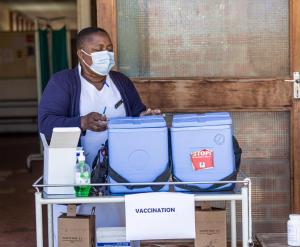Zimbabwe tackles measles outbreak through intensive vaccination campaigns
Harare – When Baba Ruvheni heard health workers from his village talking about a measles outbreak in the country, he thought twice before getting his grandchild vaccinated. “Rumours in our community said these vaccines were for COVID-19, which was confusing. But the village health workers explained to us how dangerous measles could be and that the best protection was the vaccine,” says the farmer from Seke District, located just south of the Zimbabwe’s capital Harare. “The minute the measles vaccination campaign was announced, l made sure l was one of the first people to bring my granddaughter.”
Ruvheni’s granddaughter is now one of nearly 2 million children in Zimbabwe to have received the measles vaccine during the first phase of a mass vaccination campaign that began on August 2022 and aimed to reach around 2.3 million children aged between 6 months and 5 years by 9 September 2022.
Launched by Zimbabwe’s Ministry of Health and Child Care (MoHCC) after a measles outbreak emerged in the country’s eastern Manicaland Province,å which borders Mozambique, in April 2022, the measles vaccination campaign played a crucial role in bringing the outbreak under control. By 30 September 2022, nearly 7,701 cases and 747 deaths have been recorded across Zimbabwe, making this the worst measles outbreak to have ever afflicted the country. New cases dropped significantly towards the end of 2022 because of the comprehensive response to the outbreak by the country, with vaccination playing a significant role.
Debunking rumours
When the vaccines were first introduced, health authorities had to tackle vaccine hesitancy. “To address this issue, we engaged all community health workers and sensitized them so they could raise awareness at the local level and encourage vaccination and early treatment-seeking behaviour,” explains Norman Dzirambi, Health Promotion Manager at the MoHCC. “In addition to debunking rumours circulating in the media and on social media, this grassroots approach has helped us to achieve 94% vaccination coverage in the Mutasa District, where the outbreak started.”
Initially, rumours and misinformation about COVID-19 vaccines had fuelled vaccine hesitancy in the region and delayed the containment of the outbreak. Vaccine hesitancy decreased when community health workers, as well as local religious and traditional leaders, became actively engaged in mobilizing their communities for the measles vaccination campaigns.
“We took advantage of existing community health meetings, which we already held every month,” says Anali Sigauke, a village health worker in the Chipinge area of Manicaland. “We worked with our village leader to call for emergency meetings which all villagers attended. We talked through the campaign and the importance of getting children vaccinated. These meetings allowed people to ask questions and get the right information from us.”
Health workers also went door-to-door to encourage people to get their children vaccinated, while health facilities adopted flexible opening hours to accommodate families who preferred to do so in confidence.
Vaccine hesitancy was not the only challenge health workers faced in their mobilization efforts. “Most of our community members are self-employed and did not want to miss out on economic activities while waiting to receive services at the clinic,” says Violet Gutsa, a health worker from Seke District.
Increasing vaccine uptake
By scheduling specific dates and times in different villages, she and her colleagues could accompany people to the nearest health facility, which helped increase vaccine uptake. Health workers were also recruited for the campaign from among hesitant groups. “One of the key drivers of our success is the trust and confidence we have built with our community over the years,” Gutsa adds.
World Health Organization (WHO) supported local health authorities in planning, implementation and monitoring of the measles vaccination campaigns and to enhance surveillance through intensified active searches for cases and the provision of technical guidelines to primary health facilities. The WHO also supported shipment of samples taken from suspected cases and processing the samples in the laboratory. Additionally, the WHO helped to strengthen case management through provision of technical guidance on measles case management including on use of vitamin A, which reduces the risk of complications and deaths due to measles, as well as antibiotics and other medical supplies.
No more children should die from this disease
“Despite strong initial vaccine hesitancy, national and local health authorities have mounted an efficient response to this outbreak, addressing people’s concerns, explaining the benefits and safety of vaccines and helping to implement a robust detection system,” says Professor Jean-Marie Dangou, WHO Representative in Zimbabwe. “We must all continue to play our part to ensure that no more children die from this disease.”
With support from Gavi, the Vaccine Alliance, United Nations Children’s Fund (UNICEF) and WHO, Zimbabwe conducted the second phase of the vaccination campaign between 30 January 2023 and 9 February 2023, targeting all children who were not reached during the first phase. This second round was conducted in 10 priority districts and allowed to vaccinate 475 368 more children in February 2023.
The outbreak seems to be now under control. According to the Weekly Disease Surveillance System (WDSS) report of week ending 29 January 2023, the cumulative measles cases for the period 1-28 January 2023 were 6 cases and 0 deaths.
